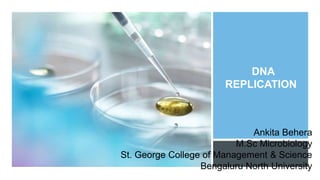
DNA
- 1. DNA REPLICATION Ankita Behera M.Sc Microbiology St. George College of Management & Science Bengaluru North University
- 2. INTRODUCTION The genetic material must produce a large number of copies of itself during the lifecycle of an organism that must undergo replication. The process of replication is that reproduces the information present in the DNA undergoing replication. At the same time , it must allow a very small degree of mutation to occur new genetic variation continues to arise. DNA is damaged by various physicochemical factors of the environment .These damages must be repaired without causing a change in the genetic information contained in the DNA.
- 3. “ DNA REPLICATION IS THE BIOLOGICAL PROCESS OF PRODUCING TWO IDENTICAL REPLICAS OF DNA FROM ONE ORIGINAL DNA MOLECULE”
- 4. THERE ARE 3 POSSIBLE MODES OF DNA REPLICATION:- • In this mode the parent DNA molecule is broken into several pieces and the new molecules will consist of both old and newly synthesized segments. DISPERSIVE • In this method the 2 old strand will be present in one daughter molecule while the two newly strands would from the second daughter molecule. conservative • In this method each daughter DNA molecule consists of one old and one new strand.semiconservative
- 6. All evidence clearly indicates the DNA replication is semiconservative because in Semiconservative DNA replication each newly synthesized strand of DNA is associated with the old strand against which it was synthesized. Thus, each progeny DNA molecule consist of one old and one newly synthesized strand. Semi-conservative mode of DNA replication was postulated by WATSON and CRICK along their double helix of DNA. The DNA molecule that undergoes replication is termed as “PARENT MOLECULE” or “TEMPLATE MOLECULE”. WHILE The 2 molecules produced by replication may be termed as “PROGENY MOLECULES” or “DAUGHTER MOLECULES”.
- 7. THE MAIN FEATURE OF THIS MODEL OF DNA REPLICATION ARE- Progressive separation of the two strands of the DNA molecule undergoing replication. Complementary base pairing of the bases located in the single stranded regions, thus produced with the appropriate free Deoxyribonucleotides. Formation of phosphodiester linkages between the neighbouring Deoxyribonucleotides that have base paired with the single strands , there by producing the new strand . It ensures that the base sequence of the new strands are strictly complementary to those of the old strands Each DNA molecule produced by replication has “one old” and “one new” strand. Clearly the old strand of DNA molecule serve as templates or molds for synthesis of new strands .
- 8. EVIDENCE OF SEMICONSERVATIVE DNA REPLICATION:- The evidence for semi-conservative replication of DNA was first presented by “MESELSON AND STAHL”.
- 14. REPLICON A replicon is the segment of DNA ,i.e , capable of DNA replication independent of other segments of DNA. So each replicon has 1)origin(DNA replication begins) 2)Terminus(DNA replication stops) Prokaryotes contains single replicon per chromosome but eukaryotes is made up of several replicons. Replicon size varies from 40kb-300kb.
- 15. origin • The sequence of replicon that supports initiation of DNA replication is called “ORIGIN”. • It also controls the frequency of replication of the replicon. • For ex:-E.coli origin is known as “oriC” • It is easy unwinding of the two strands during replication. • It function is a species –specific manner . terminus • It stop replication fork movement and thereby , terminate DNA replication. • For ex:-E.coli chromosome has 2 termini one on each strand which is termed as “ter” E , D , A and ter C, B • Termination requires “tus”gene product which recognizes and binds ti “ter” sequence and stops the progress of replication .
- 16. PROTEINS INVOLVED IN DNA REPLICATION:-
- 17. DNA POLYMERASE:- I t is the chief enzyme of DNA replication . Discovered by KORNBERG in 1956 . There are 3 types of DNA polymerase :-DNA polymerase 1 , 2 , 3 They require to follow this rules:- i)Add template DNA strand ii)A short primer iii)A free 3’-OH in primer iv)Also add one nucleotide at a time to free 3’-OH primer and extend 5’->3’ direction.
- 18. DNA polymerase I • It is an DNA repair enzyme. • 5’-3’ polymerase activity is responsible for primer extension or DNA synthesis. • It is involved in excision of DNA strands during DNA repair and removes 10 bases at a base. • 3’->5’ exonuclease activity remove only 1 nucleotide at a time. • It does commit error in DNA synthesis. • Molecular weight 1,09,000 DNA polymerase II • Molecular weight is 1,20,000. • It function is a DNA repair. • 5’->3’ polymerase and • 3’->5 exonuclease uses as template only such DNA duplexes have short gaps. DNA polymerase III • Molecular weight is 2,50,000. • Helps in DNA replication in vivo. • Catalyzes DNA synthesis at high rates . • 15,000bases /min at 37 degree celcius.
- 19. PRIMASE This enzyme activity catalyzes the synthesis of RNA primers to initiate DNA replication. Ex:- Dna G , DNA polymerase ꬰ
- 20. POLYNUCLEOTIDE LIGASE:- DNA ligase or polynucleotide ligase catalyzes the formation of phosphodiester linkage between 2 nucleotide of DNA strand . It seals the nicks remaining in a DNA strand which follow DNA replication or DNA repair. It also fills gaps in DNA strands.
- 21. ENDONUCLEASES:- It produces an interval cut in a DNA molecule. It produces cuts only at those sites that have a specific base sequence. It induce a nick to initiate DNA replication.
- 22. PILOT PROTEINS:- they are produced by most viruses. It is associated with viral genomes and determines the viral DNA will undergo replication.
- 23. HELICASE:- It effects strand separation at forks and uses 1 ATP molecule for each base i.e separated.
- 49. THANK YOU